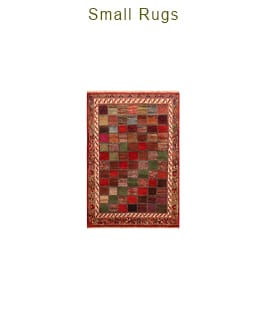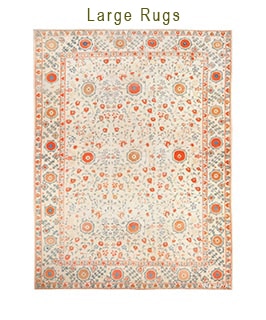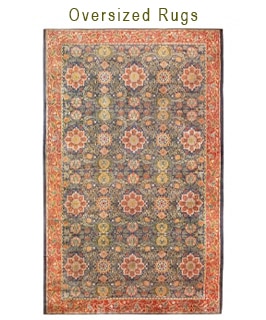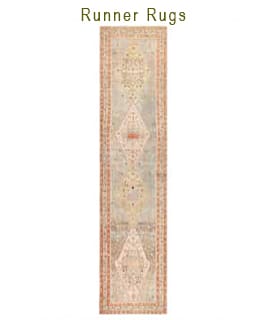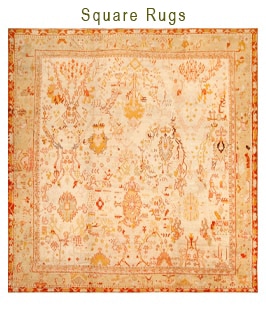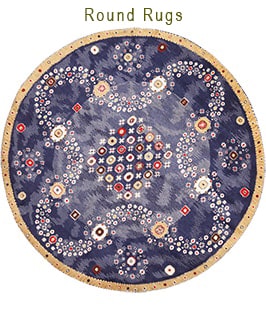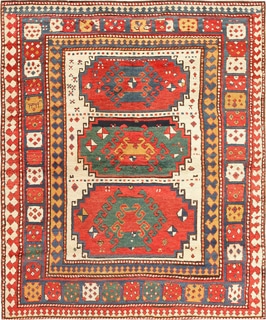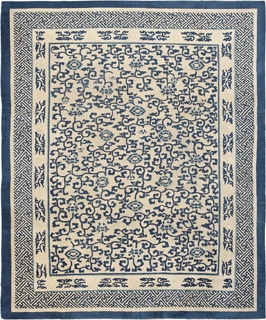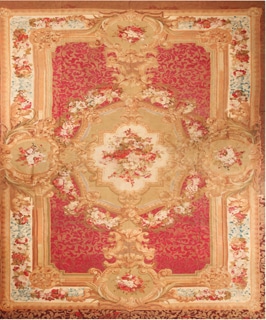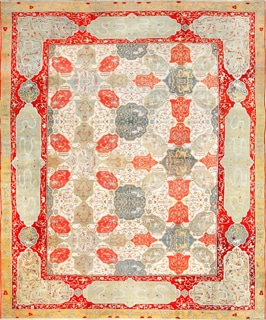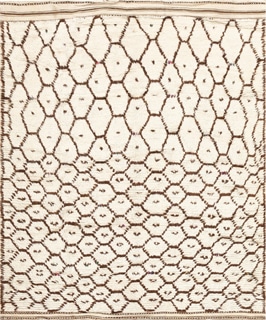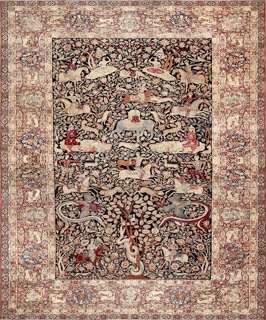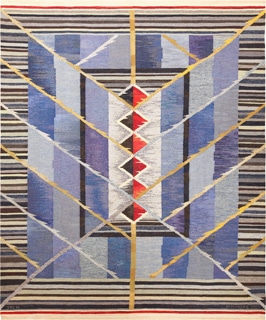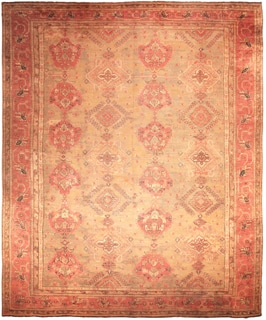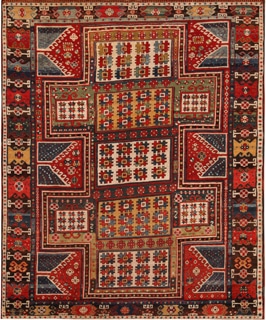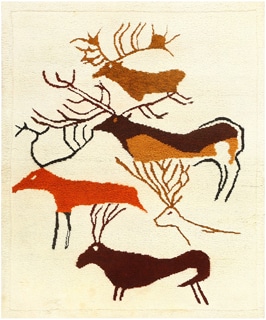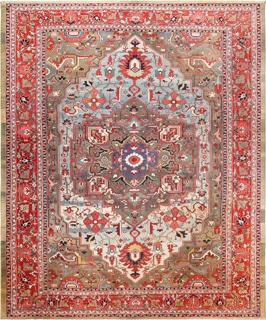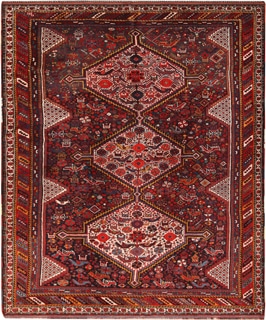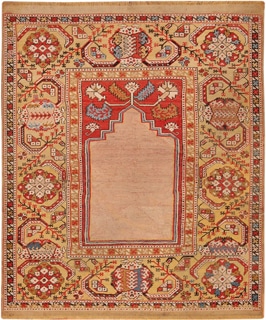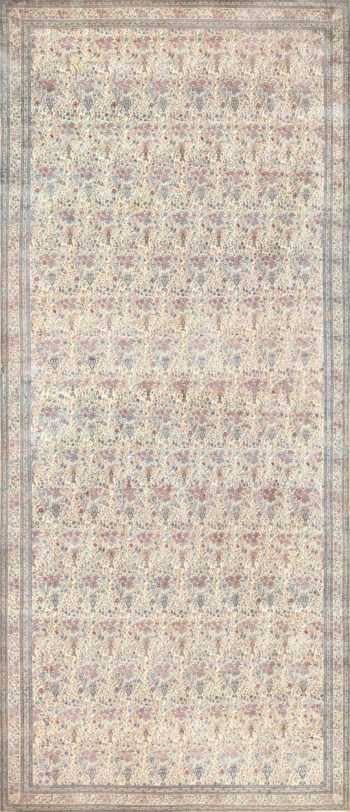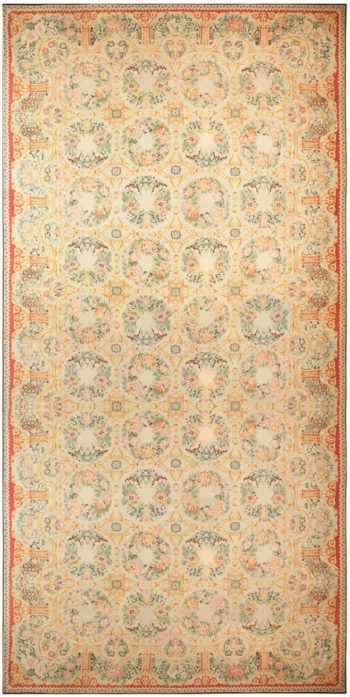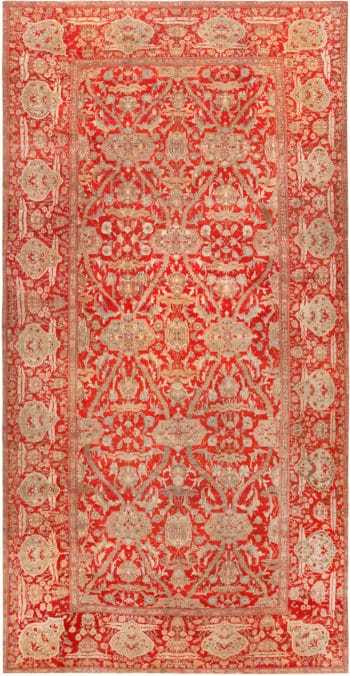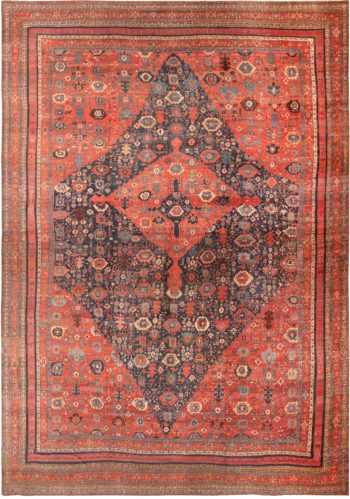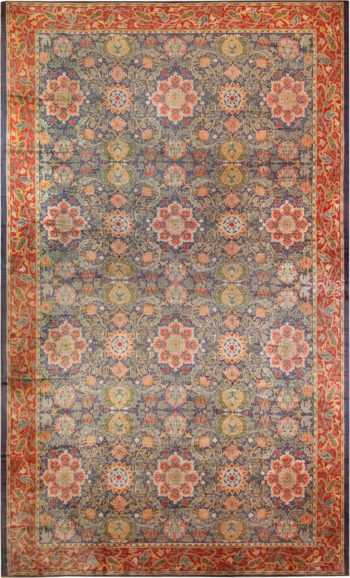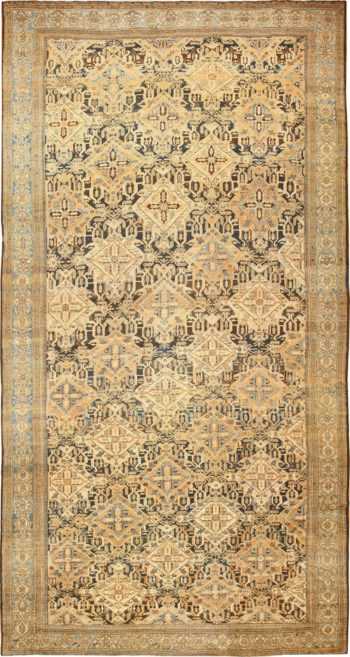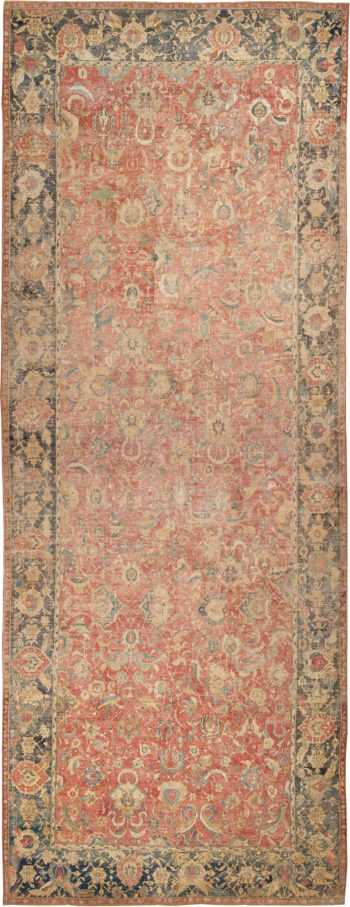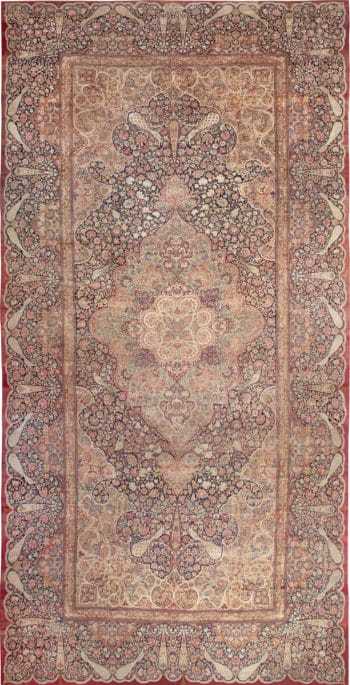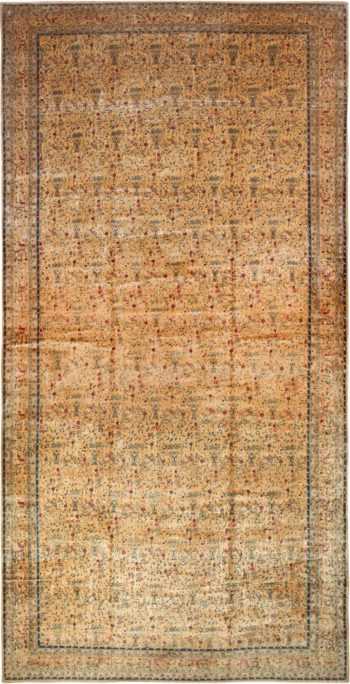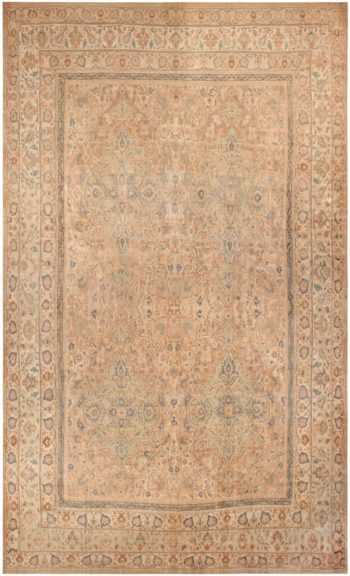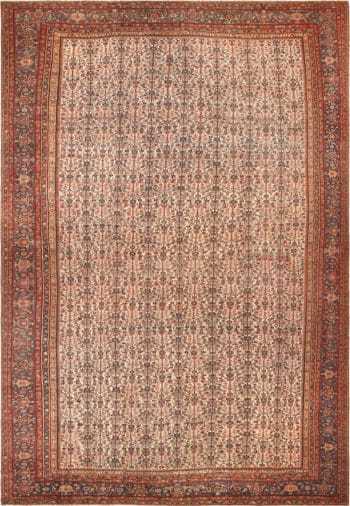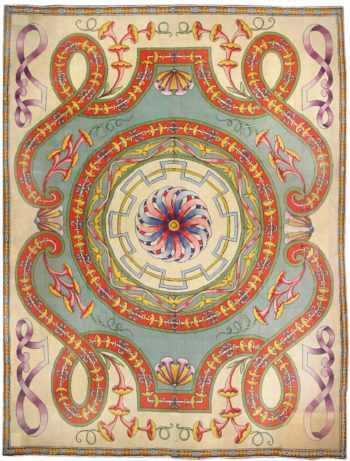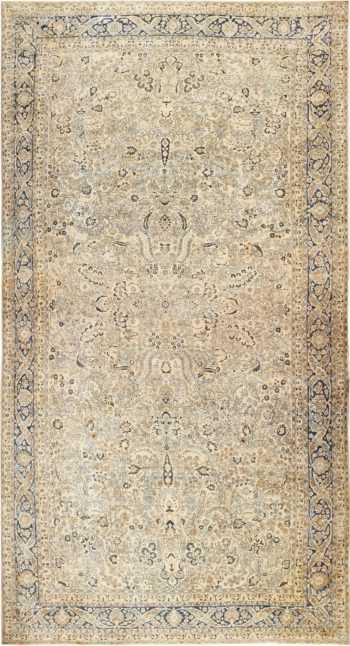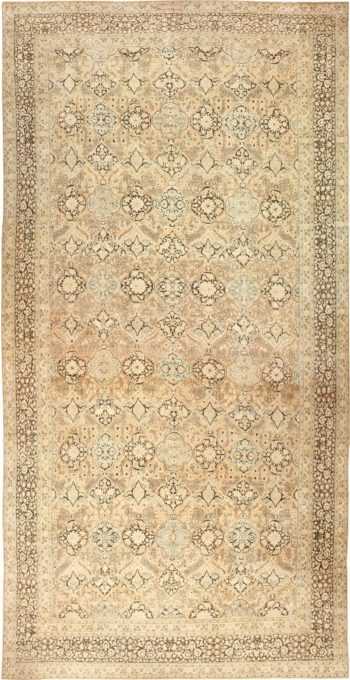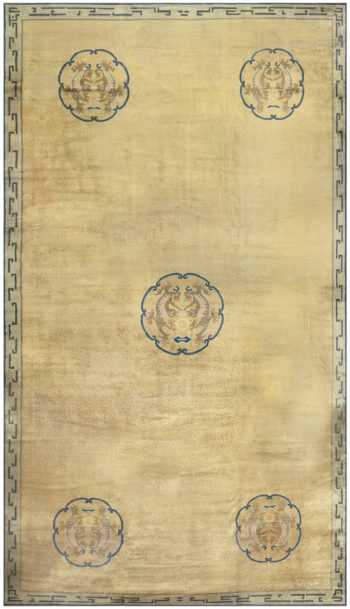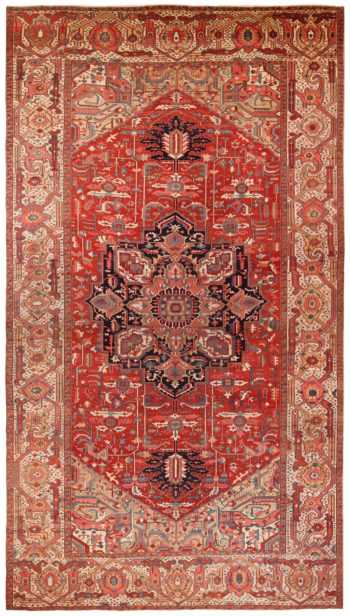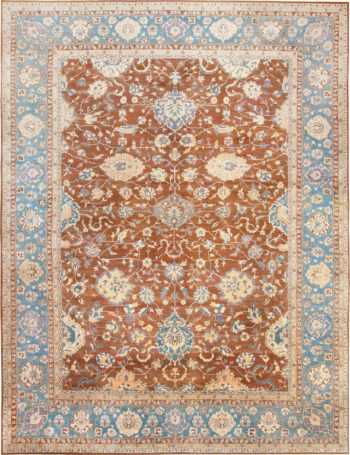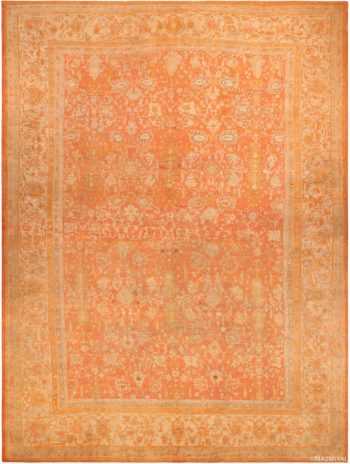Antique Rugs Online
Shop the Most Comprehensive Collection of Antique Area Rugs Online in the World
Search the World of Antique Rugs Online by Name, Origin, Color, Pattern, Rug Number, Size and Price. How to search
Let our experts help you find the ideal rug
Search For Antique Rugs Online by Their Name:
View All Rug Styles and Types…
Search for Antique Area Rugs Online by Their Origin:
Search Antique Area Rugs Online by Their Pattern:
View List of All Rug Patterns…
How Old Does A Carpet or Rug Need To Be To Be Called Antique?
To be able to reference any carpet or rug as an “antique”, it would need to be at the very least, 80 years of age.
What does the term “antique rugs” mean?
The expression “old fashioned floor coverings” alludes to rugs or covers that are both old and important because of their age, craftsmanship, and frequently, verifiable or creative importance. These carpets are regularly handwoven and can emerge out of different locales of the world, like the Center East, Asia, Europe, or North Africa.
The Roots Of Antique Rug History
The historical backdrop of antique floor coverings is a rich and interesting excursion that traverses hundreds of years and includes different societies and civilizations. These dazzling materials have been woven by talented craftsman’s for both useful and imaginative purposes. The underlying foundations of antique rug history can be followed back to antiquated times, with various areas and time spans adding to the turn of events and development of floor covering making customs.
Here is an outline of the critical achievements throughout the entire existence of classical rugs:
- Antiquated Beginnings: The earliest proof of carpet making traces all the way back to old civic establishments in Egypt, Mesopotamia, and China, around 2000 BCE. These early rugs were fundamentally utilitarian, utilized for warmth and security against cold floors.
- Persian Rugs: Persian rugs are the absolute most popular and pursued classical floor coverings on the planet.
- The specialty of carpet winding in Persia (current Iran) can be followed back to the Achaemenid Domain (around 550-330 BCE).
- The city of Isfahan turned into a famous place for floor covering creation in the sixteenth and seventeenth hundreds of years, delivering profoundly unpredictable and rich rugs.
- Persian floor coverings frequently highlight many-sided flower and mathematical plans, and their quality and craftsmanship are considered among the best on the planet.
- Oriental Rugs: Oriental rugs, which incorporate Persian carpets, are known for their many-sided examples and rich tones. These rugs have been created in areas across Asia, including Iran, Turkey, Focal Asia, and the Caucasus.
- The Silk Street assumed a critical part in the spread of carpet making strategies and plans all through Asia and into Europe.
- Islamic Workmanship and Mamluk Floor coverings:
- In the archaic Islamic world, particularly during the Mamluk Sultanate in Egypt (1250-1517), the craft of rug winding around prospered. Mamluk carpets are known for their perplexing mathematical examples and rich tones.
- European Impact:
- During the Renaissance, European honorability started gathering Oriental and Persian floor coverings as extravagance things. This prompted the consolidation of floor covering themes into European craftsmanship and plan.
- Classical Floor covering Creation in Europe:
- By the sixteenth hundred years, European nations, for example, France and Spain started delivering their own antique-style carpets, frequently mixing conventional Oriental themes with European plan components.
- Provincial America:
- Antique floor coverings advanced toward provincial America through exchange and trade. These carpets filled both embellishing and commonsense needs in frontier homes.
- Expressions and Specialties Development:
- In the late nineteenth and mid twentieth hundreds of years, Human expression and Specialties Development in Europe and the US accentuated hand tailored things, including carpets. This prompted a resurgence in the enthusiasm for collectible and classic floor coverings.
- Recovery and Gathering:
- In the twentieth hundred years, there was a resurgence of interest in old fashioned carpets, especially Persian and Oriental floor coverings. Gatherers and fans searched out these noteworthy pieces for their imaginative and social worth.
Today, antique floor coverings keep on being esteemed for their imaginativeness, social importance, and verifiable worth. They are gathered, showed, and appreciated around the world, protecting the rich and various tradition of floor covering making customs.
Key attributes of antique rugs might include:
- Age: Antique carpets are normally something like 100 years of age, albeit the particular age that qualifies a floor covering as classical can shift contingent upon the source or well-qualified assessment.
- Hand tailored: These floor coverings are customarily made by gifted craftsman utilizing conventional winding around methods. Handwoven carpets are viewed as more important and collectible than machine-made rugs.
- Special Plans: Antique area carpets frequently include unpredictable and extraordinary plans, examples, and themes. These plans can be intelligent of the way of life, district, or time span in which the carpet was made.
- Top notch Materials: They are frequently created from great normal materials, like fleece, silk, or cotton. The nature of the materials utilized can altogether influence the floor covering’s sturdiness and worth.
- Verifiable or Creative Worth: A few antique rugs and older floor coverings are viewed as craftsmanship pieces or have verifiable importance, making them exceptionally pursued by gatherers and fans.
- Extraordinariness: Antique floor coverings become more uncommon with time as they age, which can add to their worth.
- Patina: The normal maturing and wear of an antique carpet can make a helpful patina that improves its personality and worth.
Authorities, inside decorators, and people inspired by history and culture frequently search out classical carpets for their tasteful allure and authentic importance. These carpets can shift generally in style, beginning, and cost, making the universe of classical carpets a different and entrancing field of review and gathering.
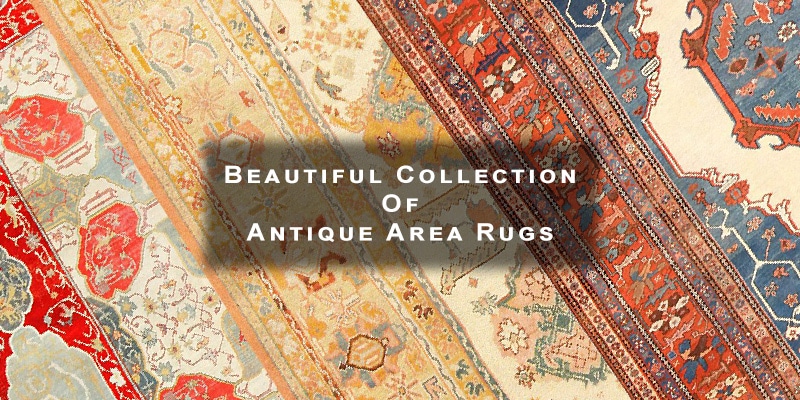
Antique Rugs And Carpets by Nazmiyal
20th Century Area Rugs
Region floor coverings have been a necessary piece of inside plan and home stylistic layout all through the twentieth hundred years. The twentieth century saw a large number of styles, materials, and configuration patterns in the realm of region floor coverings.
Here is a short outline of probably the most prominent twentieth century region carpet styles:
- Art Deco Carpets (1920s-1930s): The Craftsmanship Deco development affected numerous parts of configuration, including region floor coverings. These floor coverings highlighted intense mathematical examples, sharp points, and dynamic tones. They were frequently produced using sumptuous materials like silk or fleece.
- Mid-Century Current Rugs (1940s-1960s): Mid-century present day plan underscored effortlessness, usefulness, and an association with nature. Rugs from this period commonly highlighted dynamic or natural examples with an emphasis on hearty tones and regular strands like jute or fleece.
- Shag Floor coverings (1960s-1970s): Shag carpets acquired notoriety during the 1960s and 1970s. They were known for their long, delicate heap, frequently made of manufactured materials like acrylic or polyester. The tones were much of the time strong and dynamic, and these rugs were related with a crazy, unique tasteful.
- Persian Rugs: Conventional Persian floor coverings kept on being well known all through the twentieth 100 years. They are known for unpredictable, handwoven plans and rich, warm varieties. Persian carpets never truly became unpopular and stay ageless pieces in many homes.
- Kilim Rugs: Kilim carpets, which begin from different areas, for example, Turkey and the Balkans, acquired prominence during the twentieth hundred years because of their level woven development, mathematical examples, and splendid varieties. They were in many cases utilized in mid-century and bohemian insides.
- Scandinavian Rugs: Scandinavian plan, known for its straightforwardness and usefulness, additionally reached out to region carpets. These floor coverings regularly highlighted moderate examples and a restricted variety range, with an emphasis on normal materials like fleece.
- Moroccan Rugs: Moroccan rugs, like Beni Ourain carpets, acquired notoriety during the twentieth hundred years for their ancestral and moderate plans. They frequently highlighted highly contrasting mathematical examples and were handwoven by Berber clans in Morocco.
- Oriental Rugs: Oriental rugs from locales like India, China, and Turkey kept on being famous all through the twentieth hundred years. They frequently highlighted many-sided examples and rich, warm tones, making them ageless pieces in different inside styles.
- Contemporary and Dynamic Rugs: As the twentieth century advanced, contemporary and conceptual plans in region carpets turned out to be more noticeable. These carpets frequently included strong, exceptional examples and varieties, taking care of a more present day and mixed fashion instinct.
Region carpets from the twentieth century keep on being famous decisions in inside plan because of their variety and the capacity to supplement different enhancing styles. Whether you favor the rare appeal of a shag rug or the immortal class of a Persian floor covering, there are various choices to browse to suit your own taste and home style.
Antique Rugs Vs. Modern Rugs
Antique carpets and present day carpets are two particular classes of rugs with different contrasts concerning style, plan, materials, and worth.
Here is a correlation of antique carpets versus modern rugs:
- Age and Beginning:
- Classical Carpets: Antique floor coverings are normally something like 100 years of age and are many times handcrafted utilizing conventional winding around strategies. They frequently come from locales with rich carpet making customs, like Persia (Iran), Turkey, the Caucasus, and Focal Asia.
- Present day Carpets: Current floor coverings are contemporary manifestations, normally made inside the most recent couple of many years. They can emerge out of different locales overall and may integrate a great many plans and materials.
- Plan and Style:
- Old fashioned Floor coverings: Antique carpets frequently highlight conventional and perplexing plans, with designs that mirror the way of life and history of the area where they were made. Well known styles incorporate Persian, Oriental, and ancestral plans.
- Present day Carpets: modern rugs offer an extensive variety of plan prospects, from moderate and unique examples to strong, contemporary plans. They are impacted by current plan drifts and can change significantly in style.
- Materials:
- Classical Floor coverings: Antique carpets are normally created from regular materials like fleece, silk, and cotton. The fleece is many times hand-turned and normally colored, which can add to their remarkable maturing attributes and patina.
- Present day Carpets: Current floor coverings can be produced using various materials, including engineered strands like polyester and nylon, as well as normal filaments. They may likewise integrate different winding around strategies and manufactured colors.
- Esteem:
- Classical Carpets: Antique rugs frequently have a higher inborn and gatherer’s worth because of their age, craftsmanship, and verifiable importance. Uncommon antique carpets can be important ventures and value in cost over the long run.
- Current Floor coverings: Present day carpets are by and large more reasonable than old fashioned carpets. While some cutting edge creator rugs can be important, their worth will in general be affected by the ongoing plan market as opposed to verifiable importance.
- Condition and Wear:
- Classical Carpets: Antique floor coverings might give indications of wear and maturing, which can add to their appeal and character. Notwithstanding, their condition can shift generally, and a may expect rebuilding to keep up with their honesty.
- Modern Rugs: Present day carpets are commonly in new or previously owned condition, with practically no indications of wear. This settles on them a pragmatic decision for high-traffic regions.
- Capability and Use:
- Classical Rugs: Antique carpets are in many cases thought about more as craftsmanship pieces or gatherer’s things. They are appropriate for formal living spaces and rooms with lower pedestrian activity.
- Modern Rugs: Present day carpets are flexible and can be utilized in many settings, from contemporary homes to business spaces. They are more utilitarian for ordinary use.
In rundown, the decision between classical carpets and current floor coverings relies upon your own style, spending plan, and expected use. Antique floor coverings have authentic and creative worth, while present day rugs offer contemporary plan choices and reasonableness.
An Introduction to the World of Antique Carpets and Area Rugs:
The Origin and Evolution Of Antique Area Rugs Throughout History
The history of area carpets and rug weaving is complex. It is one that is fraught with lingering scholarly questions. While the recent history of artisanal rug weaving is well documented, and while certain areas have kept reliable historical records, there is, in fact, little consensus regarding the genesis of the craft.
Most people would not be able to make an educated guess as to the origins of rug production. That said, it is true that most people, in the Western world, associate the earliest rugs with the part of the world that we call the “Near East”.
Indeed, rug weaving has been an important cultural practice, in many Near Eastern countries, for centuries. However, the academic general consensus, while far from unanimous, suggests that the region was not the birthplace of rugs. This is despite its long and ancient history of rug production.
In fact, the incomplete historical record, of rugs, does show, that rug weaving was a practice that was independently developed by a myriad of peoples across the world. The record becomes especially vague when talking about the history of knotted pile rugs.
It is an established historical fact, that the Near Eastern empires were the commercial centers of rug productions. Throughout the Medieval Era, it is also well established, that these places were not the first to weave knotted or pile rugs.
The Nomadic Genesis Of Area Rugs
To find out more about the genesis of the knotted carpet, one must venture into prehistory. That is when most of mankind lived a nomadic existence.
In their most basic form, rugs today function much as animal hides and skins functioned for our nomadic ancestors.
For centuries, the nomadic people utilized animal skins for a variety of functions. That said, it is relatively unclear when people began to sheer the fur and wool from certain animals to use in weaving.
The Animals Who Make Area Rugs Possible
Naturally, the advantages of sheering over killing an animal are enormous. A dead animal yields a very finite amount of hide. In contrast, a living animal, that was sheared, offers a practically limitless supply of material.
This was a simple, but immeasurably important realization in the history of human evolution. Now our nomadic ancestors found themselves with more resources than they were accustom to having. As such, the nomadic peoples, were now able to experiment with wool and other similar materials, in ways that were previously unimaginable.
Dyeing Wool For Rugs
The relatively bright wool, given by sheep, was well suited for dyeing. That is precisely what the earliest rug makers did. Plant materials, insects and a variety of other natural materials were all used to extract dyestuff. These colors were then applied to the wool. This colored wools was then used to create the first rugs with patterns and culturally significant symbols.
The Birth Place Of Pile Area Rugs and The Story Of The Pazyryk Carpet
It is the High Altai Mountains of Siberia, in modern day east-central Russia, that seems to be the most likely birthplace of the pile rug. The earliest human inhabitants of this region were in fact nomadic.
Unlike their cousins in the Near East, these people had a vested interest in developing new methods for keeping warm. Over time, the peoples of the High Altai Mountains become very invested in rug production. That is why were soon adorning their rugs with distinct and symbolic patterns.
The earliest reliable records suggest the High Altai peoples were weaving pile rugs as early as 600 BCE.
The best evidence for this hypothesis is attributed to a series of excavations carries out by Russian archaeologists at a pair of locations in the High Altai. Those sites were the tombs of Bash-Adar and Pazyryk in southern Siberia.
At Bash-Adar, a partial fragment of a pile rug was discovered. This simple, un-decorated rug fragment, was carbon-dated to 600 BCE.
Meanwhile, a considerably more headline grabbing discovery was made at the tomb of Pazyryk. There, a largely intact pile rug was discovered encased in ice. This ancient area rug, which is widely referred to as the Pazyryk rug, dated to the fifth century BCE.
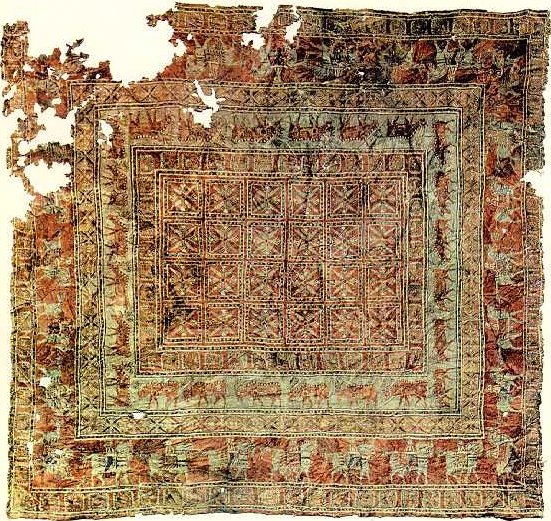
The Pazyryk Carpet
While initially in a very distressed state, the frozen rug was eventually carefully and painstakingly restored. This process revealed a truly remarkable ancient area rug.
Complex detail work appears throughout the remarkable antique carpet. A pattern of squares graces the center, with each square decorated with floral patterns.
Woven into the borders are a series of further floral details. This is in addition to the meticulously woven griffins and the procession of horsemen.
The rug colors are as impressive. They feature shades of red, blue, green gold throughout this remarkable composition.
This is an astonishing level of detail and color. It also boasts an impeccably fine weaving technique. This has led many scholars to conclude that the Pazyryk carpet must be Persian in origin – NOT the work of a band of Siberian nomads.
This disagreement, is the source for most of the academic disagreement, regarding the genesis of hand knotted or pile rugs.
Was the Pazyryk carpet is of Persian origin?
Also excavated at Pazyryk, were a smattering of ancient Persian textiles. These ancient textiles were discovered in addition to the Pazyryk carpet itself.
Does this evidence mean that the Pazyryk carpet is of Persian origin itself? Or does it mean that the Altai nomads attempted to reproduce something that they found beautiful?
There is, as of yet, no fully agreed upon answer. However, there is evidence to suggest that Pazyryk carpet was in fact a local creation, woven by the Altai nomads.
More specifically, the fallow deer that are woven into the rug, leads some experts to believe that is was, in fact, a locally produced piece. That is because these animals are neither indigenous to Persia, nor were they a common motif in Persian period textiles. These deer are actually common in other artistic media from the High Altai region.
Further, the wool and dyes that make up the Pazyryk carpet seem to be local to the High Altai region as well. Thus it is likely, but far from certain, that this particular ancient rug was, in fact, woven by the nomadic peoples of the High Altai Mountains. Not by the Persians with whom they evidently enjoyed trading.
Numerous examples support the hypothesis that weavers in this part of the world (the Russian Far East) were influenced by the weavers of the Near East. Ample archaeological evidence suggests that it was common for those weavers outside of Persia, to weave rugs in imitation of the style.
The Dark Ages of Area Rugs
There is an enormous gap between the weaving of the Pazyryk carpet, in the fifth century BCE, and the reemergence of knotted rugs, which date back to the fifth century AD (in Roman occupied Egypt).
Meanwhile, a scattering of evidence suggests, that area rugs were woven during this period. Mostly in places such as the Caucasus and Central Asia. Further, the archaeological record suggests that nomadic tradition of weaving looped carpets, proliferated from the High Altai Mountains into China and Tibet. There the craft was modified.
The precise genesis of the “area rug” is unclear. Also, the historical records are spotty. That is why there isn’t a good body of knowledge regarding the early days of this craft.
What is known, is that rugs have been an important part of human history for millennia. The academic world has been fascinated by rugs. This fascination is fueled by the fact that people have most likely been weaving rugs since before they were writing.
Antique rugs represent a unique development in human culture. They also offer some of its greatest mysteries and delights.
What to Consider When Looking for an Antique Rug
Are you looking to buy rugs? Well, if you are, the chances are that you’ve got some questions. Luckily, that’s just what we’re here for! After all, choosing the right antique rug for you and your home can be a challenge.
There are practically countless styles of of these captivating old area rugs on the market today. In addition, they also come in a huge range of quality, size, and origin.
But fret not! While there is tremendous variety of different types of rugs, not all of them will right for your needs.
Some rugs you’ll be able to eliminate straight out of the gate. With others, you may need to spend a little more time considering your needs.
There are various considerations to keep in mind while looking for a rug:
- What’s my budget?
- What size area would work best?
- What color rug should I buy?
- Do I want to buy a modern rug or an antique rug
- Would I be better served by a more durable rug than a thinner flat weave rug, like a kilim?
The above are just a couple of examples of things to thinking about when buying an antique rug. Once these considerations are addressed, the choice becomes much more focused, selective and therefor – simpler.
The initial processes when deciding to purchase new antique rugs may seem daunting. But don’t worry, things will get easier (and more fun!) once the shopping begins!
Remember, our rug site is a great resource for information. It offered you so many tools answers to questions. So when you’ve decided that it’s time to start looking for a rug, this should be our go to rug website!
Searching and Shopping for Fine Antique Rugs Online
Shopping for fine antique rugs online can be a rewarding experience, allowing you access to a wide range of options from different sellers and regions. However, it’s important to exercise caution and conduct thorough research to ensure you’re getting a genuine, high-quality product.
Here are some steps to help you search and shop for fine antique rugs online:
- Determine Your Budget: Antique and older area rugs can vary widely in price, so establish a budget before you start shopping. This will help you narrow down your options.
- Research and Learn: Take the time to educate yourself about different types of antique rugs, their origins, styles, and what makes them valuable. Understanding the differences between Persian, Turkish, Chinese, and other rugs is essential.
- Trustworthy Sources: Look for reputable online sources for older rugs. Established auction houses, well-known dealers, and specialized rug shops are good places to start. You can also check out online marketplaces, but be cautious and scrutinize sellers.
- Read Reviews: If you’re buying from a specific seller or website, read reviews and testimonials from previous customers. This can give you insight into the seller’s reputation.
- Certification and Appraisal: When buying high-value rugs that are over 100 years old, consider getting a certification or appraisal from a reputable expert. This can confirm the rug’s authenticity and value.
- Detailed Descriptions and Photos: Look for listings with detailed descriptions and high-quality photos of the rug from various angles. This will help you assess its condition, design, and colors.
- Ask Questions: Don’t hesitate to reach out to the seller or dealer with any questions or concerns. Ask about the rug’s age, origin, condition, and any restoration work that may have been done.
- Return Policy: Check the seller’s return policy to ensure you have the option to return the rug if it doesn’t meet your expectations.
- Price Negotiation: If you’re comfortable, negotiate the price with the seller, especially if you’re buying from a smaller dealer or an individual.
- Shipping and Handling: Inquire about the shipping process and associated costs. Ensure that the rug will be well-packaged and insured during transit.
- Payment Security: Use secure payment methods for online transactions, such as credit cards or PayPal, to protect your financial information.
Find and Shop for Rugs Online by Size, Shape, Style and Origin
Looking for carpets online by size, shape, style, and beginning can be a helpful and charming experience.
Decide On Your Rug Inclinations:
- Size: Measure the region where you need to put the rug. Note down the aspects to look for carpets that fit your space.
- Shape: Settle on the floor covering’s shape, whether you need a rectangular, round, square, or oval carpet.
- Style: Ponder the style you need. Carpets come in different styles, from customary and Oriental to present day and contemporary.
- Beginning: Consider on the off chance that you have an inclination for carpets from a specific locale, like Persian, Turkish, or Moroccan.
Set an antique rug spending plan:
Decide your spending plan for the floor covering. Antique carpets arrive in a wide cost range, so having a spending plan as a primary concern can assist with reducing your choices.
Antique Area Rugs And Home Decor
Antique oriental floor coverings and home stylistic layout can add a dash of immortal tastefulness and character to your residing spaces. These things frequently accompany a rich history and interesting craftsmanship that can cause your home to feel really welcoming and stylishly engaging. Here is a few data on classical region floor coverings and home stylistic theme:
1. Antique Oriental Rugs:
- Antique region floor coverings are normally handwoven and can be produced using different materials like fleece, silk, or cotton. They frequently highlight complicated designs, impeccable enumerating, and a patina that creates after some time, adding to their appeal. Normal sorts of antique carpets incorporate Persian, Oriental, Turkish, and Aubusson mats.
- Persian Rugs: Persian carpets are profoundly pursued for their multifaceted plans, quality, and history. They come from different areas in Iran, each with its own one of a kind style.
- Oriental Rugs: Oriental floor coverings are known for their customary themes and dynamic tones. They can begin from nations like China, India, and Turkey, among others.
- Turkish Rugs: Turkish floor coverings are praised for their strong mathematical examples and hearty tones. They are woven in different districts of Turkey.
- Aubusson Rugs: Aubusson carpets are French in beginning and are perceived for their rich, pastel-shaded plans. They frequently highlight complex botanical examples.
2. Antique Home Décor:
- Antique home stylistic layout things can incorporate many things like furnishings, lighting installations, craftsmanship, and ornamental articles.
-
The following are a couple of famous models:
- Antique Furniture: Pieces like classical wooden tables, seats, cupboards, and dressers can bring a feeling of history and craftsmanship to your home.
- Old fashioned Lighting: Crystal fixtures, sconces, and lights with collectible or one of a kind plans can be both practical and enriching.
- Classical Workmanship and Mirrors: Old fashioned artistic creations, figures, and lavish mirrors can act as striking central focuses in your inside plan.
- Enlivening Objects: Old fashioned jars, tickers, puppets, and other enhancing things can be utilized to add a dash of classic appeal to your stylistic theme.
-
While integrating antique region mats and home stylistic layout into your residing space, it’s fundamental to guarantee that they supplement your general plan style. Blending collectibles in with current or contemporary components can make a remarkable and adjusted look. Furthermore, be aware of the condition and credibility of classical things, as their worth frequently relies upon these variables. It’s really smart to talk with antique vendors or appraisers to evaluate the validness and worth of your old fashioned finds.
View Photo Gallery With Pictures Of Antique Rugs
View one of the most comprehensive collections of antique rugs in world:
-
Fine Ivory Floral Palace Oversized Antique Allover Oriental Persian Kerman Rug 48370
$140,000.00Size: 19 ft 7 in x 41 ft (5.97 m x 12.5 m) -
Antique Oversize Floral Romanian Bessarabian Kilim Rug 70101
$145,000.00Size: 17 ft 5 in x 34 ft (5.31 m x 10.36 m) -
Oversized Antique Persian Tabriz Haji Jalili Carpet 41353
Size: 21 ft 2 in x 32 ft 3 in (6.45 m x 9.83 m) -
Impressive Oversized Antique Persian Ziegler Sultanabad Rug 72255
$185,000.00Size: 16 ft 3 in x 32 ft (4.95 m x 9.75 m) -
Durable Rustic Palace Size Antique Tribal Persian Bidjar Rug 71773
$145,000.00Size: 19 ft 5 in x 31 ft 3 in (5.92 m x 9.52 m) -
Rich Red Jewel Tone Oversized Antique Allover Design Indian Agra Rug 72240
$165,000.00Size: 18 ft 2 in x 30 ft 10 in (5.54 m x 9.4 m) -
Antique Oversized Arts and Crafts William Morris Rug 49912
$425,000.00Size: 19 ft x 30 ft (5.79 m x 9.14 m) -
Tribal Antique Oversized Persian Bakhtiari Geometric Rug 48042
$96,000.00Size: 15 ft x 30 ft (4.57 m x 9.14 m) -
Oversized Antique 17th Century Persian Esfahan Oriental Rug 44143
$285,000.00Size: 11 ft 4 in x 30 ft (3.45 m x 9.14 m) -
Fine Oversized Floral Animal Design Antique Persian Kerman Rug 72499
$88,000.00Size: 14 ft 3 in x 29 ft 8 in (4.34 m x 9.04 m) -
Fine Palace Oversized Decorative Allover Floral Vase Deign Antique Indian Rug 70305
$110,000.00Size: 16 ft x 29 ft 8 in (4.88 m x 9.04 m) -
Extra Large and Decorative Neutral Antique Indian Agra Carpet 50110
$96,000.00Size: 16 ft x 29 ft 6 in (4.88 m x 8.99 m) -
Beautiful Oversized Fine Decorative Antique Casual Elegant Persian Khorassan Rug 71956
$148,000.00Size: 18 ft 1 in x 29 ft 1 in (5.51 m x 8.86 m) -
Oversized Antique French Art Deco Carpet 70262
$95,000.00Size: 19 ft 4 in x 29 ft (5.89 m x 8.84 m) -
Ivory Background Allover Design Oversized Antique Persian Farahan Rug 72238
$45,000.00Size: 18 ft x 28 ft 10 in (5.49 m x 8.79 m) -
Beautiful Oversized Spanish Art Deco Design Carpet 50065
$220,000.00Size: 20 ft 4 in x 28 ft 2 in (6.2 m x 8.59 m) -
Decorative Antique Oversized Persian Khorassan Rug 48825
$89,000.00Size: 14 ft 4 in x 28 ft (4.37 m x 8.53 m) -
Large Oversize Antique Persian Khorassan Carpet 47032
$96,000.00Size: 12 ft x 28 ft (3.66 m x 8.53 m) -
Large Oversized Antique Decorative Brown Earth Tone Fine Floral Persian Khorassan Rug 48922
$88,000.00Size: 13 ft 4 in x 27 ft 4 in (4.06 m x 8.33 m) -
Large Oversized Antique Dragon Chinese Carpet 50114
$69,000.00Size: 15 ft x 27 ft (4.57 m x 8.23 m) -
Oversized Antique Persian Heriz Serapi Rug 70433
$175,000.00Size: 15 ft 4 in x 26 ft 8 in (4.67 m x 8.13 m) -
Breathtaking Oversized Large Scale Antique Agra Rug 48660
$145,000.00Size: 20 ft 8 in x 26 ft 8 in (6.3 m x 8.13 m) -
Oversized Decorative Antique Turkish Oushak Carpet 71632
$165,000.00Size: 20 ft x 26 ft 6 in (6.1 m x 8.08 m) -
Long and Narrow Ivory Antique Indian Agra Runner Rug 49752
$12,500.00Size: 4 ft 6 in x 26 ft 6 in (1.37 m x 8.08 m)

